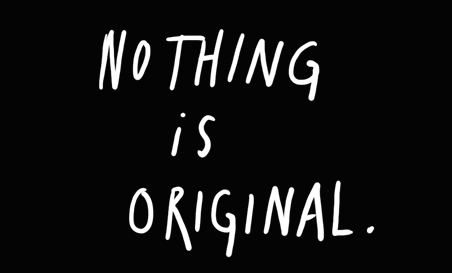The Myth of Originality
We are obsessed with being original. We look at pieces of art, listen to music, and walk by architecture while marveling at their author’s ability to make something from nothing. Then we try creating something original in our own work or art and get filled with frustration at not being able to come up with something unique and original. The thing is, originality is a myth.
To explain this better, let’s look at what original means.
To be original is to be first, to be the earliest, to be the source other people copy from. Being the first to do something is so difficult we’ve come up with phrases like “there’s nothing new under the sun” and “everything that can be created has been created before”. Yet these phrases imply that someone in an age before us was original, after all, someone must have invented fire, soap, the computer and rock music. Although some inventions seem completely new, most inventions are simply the sum of ideas that existed before them. Charcoal, sulfur and saltpeter were all preexisting materials commonly used in alchemy and medicine before it was discovered that mixing them produced black powder, or gunpowder as we now know it.
Kirby Ferguson has a great video essay called “Everything is a Remix” that illustrates how ideas build upon each other.
When we say something is original, we often mean it’s novel, and it’s a lot easier to be to be novel than original. The word novel means to be interestingly new or unusual. This means novelty lies mostly with how your audience and customer feel about you. You don’t need to do something completely new and groundbreaking, you instead need to create something that feels different and interesting to the people you seek to serve. You don’t need to be new, you need to feel new.
How to be novel
One simple way to be novel is to give your audience access to an idea that exists somewhere else, like bringing the idea of fast-casual restaurants from Australia to America, starting an Italian café in Nigeria, or even taking a Japanese show, switching out some scenes for western audiences and calling it Power Rangers. Giving your audience “new” experiences this way is easy to do, but also risky, because the product, service or experience you import may not fit in with the current culture. However, when it does fit or is adapted to fit, magic happens.
You can also combine preexisting ideas to create novel experiences. The smartphone is at its core a combination of a web browser, a mobile phone, and an mp3 player. Toms shoes are a combination of a buy one – get one free model and a clothes donation model; you simply never get the second shoe before you donate it. Both ideas, like gun powder, have familiar parts, but mix together to create fresh, noteworthy experiences for customers.
The third and easiest way to be novel is to package yourself or your product differently. Apple sparked an unboxing trend, by paying more attention to their product packaging than any of their competition, and really any other company at the time. If all your competitors sell water in plastic bottles, you could think beyond plastic and sell it in a paper box like Boxed water to stand out.
Novelty makes you stand out from your competition and leave a lasting impression with your customer. Both good and bad novel experiences leave a memorable impression with people, so create something novel and make it lovely so it becomes worth sharing.
Don’t struggle to be original, be novel.


